A shorter version of this article appears on Yale e360 as Indonesia’s Corruption Legacy Clouds a Forest Protection Plan. The version that appears below was last revised on October 31, 2010.
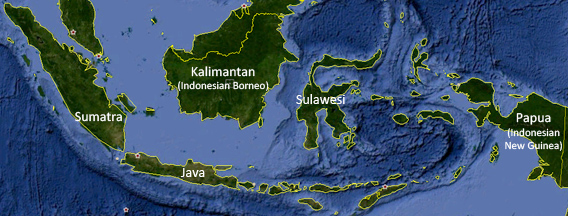
Flying in a plane over the Indonesian half of the island of New Guinea, rainforest stretches like a sea of green, broken only by rugged mountain ranges and winding rivers. The broccoli-like canopy shows little sign of human influence. But as you near Jayapura, the provincial capital of Papua, the tree cover becomes patchier—a sign of logging—and red scars from mining appear before giving way to the monotonous dark green of oil palm plantations and finally grasslands and urban areas.
The scene is not unique to Indonesian New Guinea; it has been repeated across the world’s largest archipelago for decades, partly a consequence of agricultural expansion by small farmers, but increasingly a product of extractive industries, especially the logging, plantation, and mining sectors. Papua, in fact, is Indonesia’s last frontier and therefore represents two diverging options for the country’s development path: continued deforestation and degradation of forests under a business-as-usual approach or a shift toward a fundamentally different and unproven model based on greater transparency and careful stewardship of its forest resources.
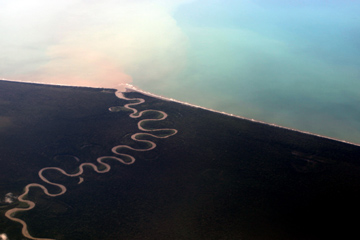 River in West Papua 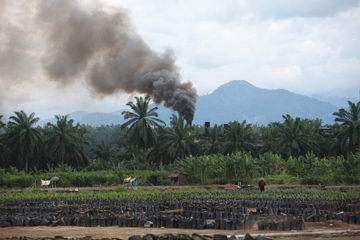 Oil palm plantation and mill in North Sumatra 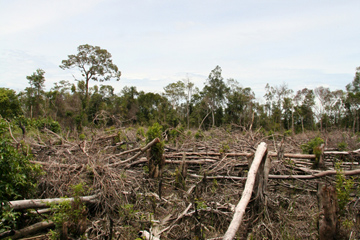 Deforestation in Kalimantan, Indonesian Borneo. Photos by Rhett A. Butler. |
Embarking on the latter path would be a shock to anyone observing trends in Indonesia over the past twenty years. Intense logging, furious expansion of oil palm and pulp and paper plantations, and forest fires have led Indonesia to seize from Brazil the crown of the world’s largest deforester. At the same time, Indonesia has become the world’s largest producer of palm oil and the largest exporter of thermal coal, while seeing its paper pulp and industrial roundwood exports increase by 20-fold and 15-fold, respectively since 1990. But these milestones have come at a high environmental cost: Indonesia’s forest cover has fallen to less than half of its land mass; fires regularly char vast areas in Sumatra and Kalimantan, triggering domestic health woes and hostilities with neighbors over air pollution; and the country is now generally acknowledged to be the world’s third largest emitter of greenhouse gases. Indonesia has thus been on a high emissions pathway, one where large sectors of the economy offer very low economic return relative to emissions. But the toll could grow: Indonesia is forecast to be among the biggest losers from climate change, chiefly the result of rising sea levels and increased incidence of drought and fire.
Yet developments over the past two years suggest that business-as-usual may not be a foregone conclusion. At the September 2009 G20 summit in Pittsburgh, President Susilo Bambang Yudhoyono surprised the world when he announced Indonesia would voluntarily reduce greenhouse gas emissions by 26 percent from a projected 2020 baseline. If the rich world chipped in, Indonesia would cut emissions—more than three-quarters of which result from deforestation—by 41%, a staggering commitment from an emerging economy. The 1.2 gigaton cut under the latter course would represent 8 percent of the total emissions reduction target set by the U.N.
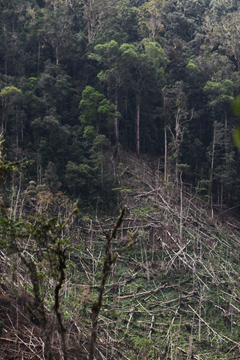 Smallholder deforestation in West Papua. Photo by Rhett A. Butler |
Norway, which has become the global champion for rainforest conservation, committing more than $1.5 billion since 2008, took the cue. In May it pledged $1 billion to Indonesia, contingent on the country’s success in reducing emissions. The two countries quickly reached an agreement, which lays out a phased approach over the next several years and spells out the need for safeguards and transparency in developing and implanting a nation-wide strategy for reducing deforestation and degradation (REDD+). But the devil lies in the details: reducing deforestation in Indonesia will not be simple. It will require taking on strong entrenched interests; determining who controls what rights to land; tackling widespread corruption; redirecting misplaced incentives that drive forest conversion; building new institutions; establishing systems for monitoring, reporting; and verifying emissions reductions; filling information gaps about the extent and ownership of forests; and reorienting the philosophy underlying use of forests in the country. Fears remain that the bold, performance-linked goal will never be attained.
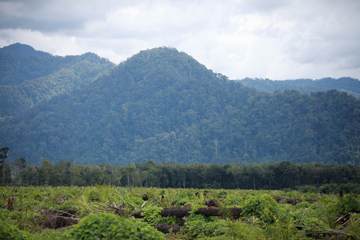 Oil palm plantation reëstablished on former rainforest land in North Sumatra |
Deforestation is Indonesia is today primarily driven by forestry industries—high commodity prices have made it more profitable than ever to log forests and convert them into pulp and oil palm plantations. However there is more to deforestation than commodity production. Weak law enforcement, lack of planning and transparency around land use, poor forest management, confusion over land rights, and poverty underlie much of the deforestation that occurs in Indonesia, whether it is caused by impoverished farmers or big corporations. None of these issues is easily solved.
“That’s the problem with REDD,” said Marcus Colchester, who runs the Forest Peoples’ Program, an indigenous rights’ group. “Supporters call it ‘low-hanging fruit’. We could save a lot of carbon by just stopping deforestation, but what that really means confronting these vested interests that do very well by deforestation. So REDD ends up being very high, floating fruit. Governments are very reluctant to take the underlying policy reforms to actually reduce deforestation.”
Many concerns about REDD in Indonesia are rooted in the history of graft in the forestry sector. Under Suharto, who ruled the country with an iron fist from 1967-1998, the forest sector was used as a mechanism for distributing wealth and power to political cronies rather than maximizing benefits for the people of Indonesia.
“It’s a source of unlimited corruption,” Chandra M. Hamzah, deputy chairman at the Corruption Eradication Commission (KPK) established by President Susilo Bambang Yudhoyono, told Reuters during an interview earlier this year.
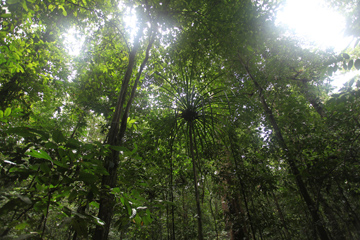 Lowland rainforest in West Papua 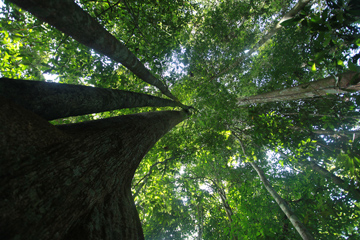 Tropical forest in Sumatra. Photos by Rhett A. Butler. |
The degree of corruption is the sector is exemplified by the country’s reforestation fund, which lost $5.2 billion between 1993-1997 through mismanagement and fraud, according to an audit by Ernst and Young. Chris Barr, formerly a policy analyst at CIFOR and now an independent consultant, says the ministry’s record of handling large sums of money should set off alarm bells for countries contributing REDD funds to Indonesia. Barr says the problems have continued well beyond the Suharto era with several hundred million dollars from the Reforestation Fund being transferred to a highly opaque financial intermediary administered by the Ministry of Forestry.
“The Ministry has budgeted these funds to finance several million hectares of new plantation development, but there has been little public accounting for how the money has actually been used. In several provinces where (the audit board) BPK has carried out audits, provincial and district authorities have routinely underspent allocations from the Reforestation Fund, often by 50% or more. These factors suggest that many of the agencies likely to manage REDD+ funds are already struggling to administer the existing flow of fiscal resources from the Reforestation Fund. REDD+ can be expected to place considerable new stresses on these institutions.”
Corruption has even touched the team that negotiated the REDD deal with Norway. In October, Wandojo Siswanto, a top negotiator at last year’s climate talks in Copenhagen, was arrested and charged with taking bribes. Siswanto had been named in two earlier corruption probes, including a 2008 incident where he admitted to accepting a $4,600 kickback from a lawmaker.
But not everyone agrees that corruption will be a hang-up for REDD in Indonesia. Agus Purnomo, a member of the Indonesian president’s Special Staff on Climate Change, is optimistic that the performance-based nature of the agreement with Norway, and REDD in general, is enough to stem concerns about corruption and distribution of carbon money.
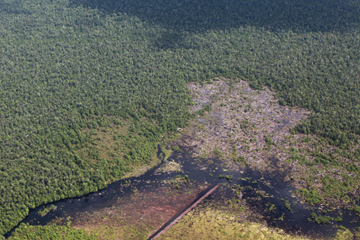 Clearing of peatland in Central Kalimantan 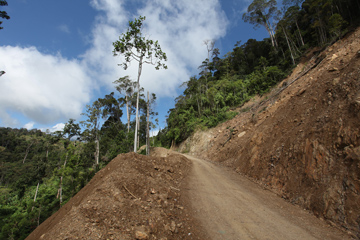 Road in West Papua. Photos by Rhett A. Butler. |
“There is no real need to make promises on the use of funds because we will be paid from the verified emissions reductions,” he said.
“Whether or not it reaches the communities or companies that take actions to reduce emission is not an issue because such reductions can only happened by working together at every levels. Without the involvements of stakeholders, such as local communities, companies, local and national government agencies, there will not be a significant reduction of emissions from forests and peatlands. Since we are serious with our commitment… we have to ensure that those who are working to reduce deforestation and peatland degradation will be properly compensated.”
Nevertheless corruption is only one of the concerns. Some who have reviewed the National Climate Change Council’s draft documents of low carbon development strategies for provinces warn that the REDD money may be used to subsidize business-as-usual approaches, including a huge expansion of processing capacity for palm oil and pulp and paper, which could increase pressure on remaining forest areas.
“The East Kalimantan low-carbon growth strategy is a document full of contradictions,” said Barr, who notes the draft plan aims to reduce carbon emissions while also expanding capacity of the province’s pulp industry by four-fold.
“In targeting 2.6 million metric tons/year of pulp capacity, the strategy promotes the development of a multi-billion industry that will consume 13 million metric tons of wood annually — or 50 percent more than the entire legal harvest from Indonesia’s HPH timber concession system! “
 Oil palm plantation in Riau Province, Sumatra 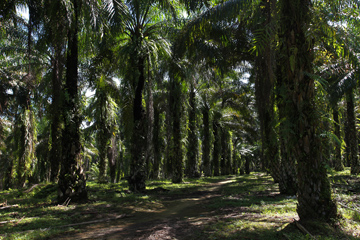 Oil palm plantation in Sumatra. Photos by Rhett A. Butler. |
Barr says the strategy indicates it will capitalize on 600,000 hectares of lands cleared for timber plantations that are currently sitting idle, but fails to acknowledge that many of these areas are owned by companies that previously received lucrative financial subsidies from the government’s Reforestation Fund to develop industrial plantations.
“In numerous cases, they simply cleared the standing timber, pocketed the subsidies, and never replanted. The notion that the government should now extend new financial ‘incentives’ to encourage the development of a pulp industry that depends on these companies for a sustainable wood supply — as part of its low-carbon growth strategy — simply defies logic. In short, the East Kalimantan proposal is seeking to have ‘business-as-usual’ bankrolled in the name of carbon emission reductions.”
As Barr notes, the projections are based on the assumption that large areas of “degraded land” can be brought into production across Indonesia. But so far, degraded lands have been an enigma. They are either too expensive to developed (logging often subsidizes plantation projects) or plagued by land rights issues, making them unattractive to industry. Land tenure problems stem from officials in Jakarta not actually knowing what land is being used. In many cases, “wasteland” isn’t abandoned, but used by communities for small-scale activities including subsistence agriculture and agroforestry. Some of this use is a product of Suharto’s transmigration program of the 1970s and 1980s, when the government sought to alleviate population pressure in central islands by subsidizing resettlement in remote parts of the archipelago. The policy also helped solidify political control over restive regions, like Indonesian New Guinea, Maluku, and parts of Sulawesi and Sumatra, and dole out concessions to Suharto’s business allies. The legacy of this system means the forestry department controls a lot of land on paper, but much of which isn’t forested and is claimed by communities. World Bank studies show that more than 60% of all land holdings in Indonesia are help under informal or customary tenures.
|
A few examples of Indonesia’s incredible biodiversity:
|
This has complicated life for both companies and communities, and promises to be an obstacle for effective REDD implementation. Today a company may win the right to develop an ostensibly abandoned concession only the find that the area is occupied.
Erik Meijaard, an ecologist formerly with The Nature Conservancy but now independent, has seen these problems first-hand.
“If we say that plantations should be developed on ‘degraded’ lands it is important to realize that most of those lands will have been claimed by local farmers,” he said. “Using those lands for plantations requires compensation for lost revenues to these farmers, and long negotiations with many stakeholders. This is one of the reasons why companies prefer to use forest rather than deforested lands.”
Getting a handle on degraded lands is thus one of the top priorities in first phase of the Norway deal. A degraded lands database will track where degraded lands exist and who owns, or at least uses, them.
“The database of degraded lands will allow expansion of agriculture and timber plantations as well as provide legal certainty for the businessman in expanding their business while avoiding deforestation,” explained Purnomo, climate change staff for the president.
The information gap extends to forestry concessions. The World Resources Institute, a policy group, is working with a local NGO, Sekala, to develop maps that reflect concession holdings, land use by communities, and degraded lands. Land swaps, whereby existing concession lands are shifted to grasslands in exchange for subsidies from carbon funds and is one course of action under the Norway agreement, will require good land use data.
Transparency also needs to extend to financial flows to reduce the risk of a repeat of the reforestation fund experience. Therefore groups like the World Resources Institute and Forest Trends are working with local partners on financial tracking mechanisms for REDD money.
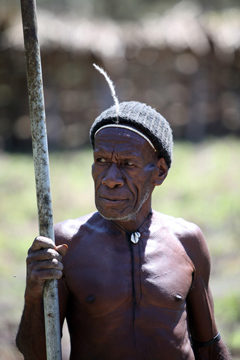 Dani man in Papua, on the island of New Guinea. 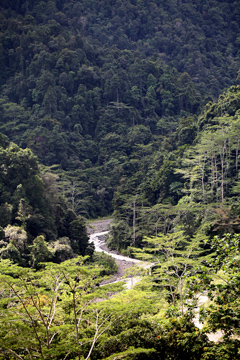 Rainforest in the Arfak Mountains of West Papua. 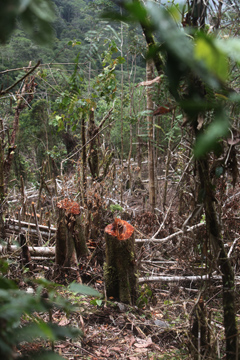 Logging in West Papua. 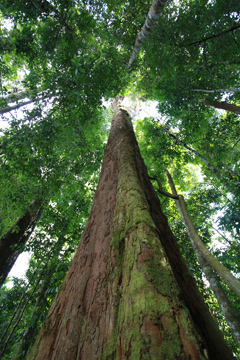 Giant Dipterocarp tree in Gunung Leuser, North Sumatra. Photos by Rhett A. Butler. |
Better financial tracking however won’t address some more complex financial issues. While it’s easy to dismiss Indonesia as a corrupt country, in reality it is like other democracies where elected leaders are under pressure to raise money. The difference is Indonesia’s middle class is much smaller, therefore the people wealthy enough to fund candidates are often associated with extractive industries. This is important because the bupati, or district head, holds a lot of power when it comes to decisions on what land will be used for agriculture and plantations.
Chip Fay, a former Senior Policy Analyst for the World Agroforestry Centre and currently a fellow at the Samdhana Institute, a think tank, says that finding ways for local government to benefit from REDD is critical to its success.
“What the international community presents is a bit smoke-and-mirrors whereas a plantation company can put something real on the table—something that is easy to understand and exists today,” he said.
Thus the transition to a low carbon economy will need to look beyond the forestry sector. It needs to stimulate livelihoods of all kinds.
“We will use such additional revenue to not only support activities in forest areas but also to build more schools, better hospitals, basic infrastructure, and to address other drivers of deforestation,” said Purnomo.
Of course jobs in the forestry sector will remain important and improved forest management is critical. Illegal logging remains rampant in Indonesia, costing the treasury more than $1 billion a year in lost revenue. Recent restrictions on imports of illegally logger timber by Europe and the United States, might help on this front by sending a demand-side signal to producers in Indonesia. Yet even legal concessions remain problematic. Currently there are few incentives for long-term sustainable management of forests and little oversight. The Ministry of Forests says that less than half the country’s 58M ha of production forest is classified in good condition.
Better management of forest concessions represents a big opportunity for greenhouse gas reductions in Indonesia chiefly because 46 percent of Indonesia’s forest area is zoned as production forest for logging (another 17 percent is set aside for plantations, of which 10.7 million hectares is still forested). McKinsey & Company, a consultancy that has developed a greenhouse gas abatement curve for Indonesia, estimates that sustainable forest management could reduce annual carbon dioxide emissions by 200 million metric tons per year at a cost of $2 per ton, well below the cost of fire prevention, reforestation, and land swaps where concession holders are given subsidies to establish plantations on non-forest land instead of forest land.
However the most important ingredient to the success of REDD in Indonesia is shifting the way businesses look at forests.
“One of the biggest barriers in the country is the current prevailing paradigm on the forest whereby there is an over emphasis on valuing the forest solely as a commercial resource. Our challenge is to disseminate a new value for forests. Forests are largely valued for timber or cooking oil that can be produced,” Dr. Kuntoro Mangkusubroto, head of Indonesia REDD+ task force, told mongabay.com. “The shift in paradigm to underscore that forests are worth more standing, along with strong law enforcement and a high transparency process as a tool to turn the tide of the history of corruption, are clear ways to save the forests.”
Erik Meijaard adds that business has a bigger role to play than conservationists in saving Indonesia’s forests.
“I don’t whether business will be brought around, but it is the best and probably only realistic hope,” he said, noting that the researchers and the government have both highlighted “severe” problems in managing protected areas. “No other sector is in a position to reduce deforestation through active management and protection of forest assets, and management is the crucial factor. Government has rarely shown an ability or commitment to managing forest assets, either protected or unprotected.”
As such it is critical that the moratorium on new concessions on peatlands and in natural forest areas have support from at least parts of the corporate sector.
“I think it is really good to have a break,” Aida Greenbury, sustainability manager for Asia Pulp & Paper, a firm much maligned by environmentalists for its logging practices, told Voice of America. “We have been under enormous criticism from all over the world. So let us just stop everything, tell us where did we do wrong and let us analyze it, see where we can improve according to national regulations and then come up with a new set of regulations or system.”
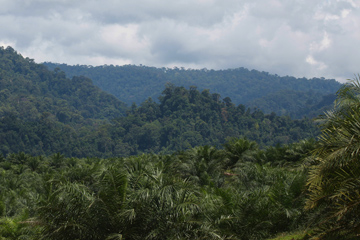 Oil palm estate in Sumatra. 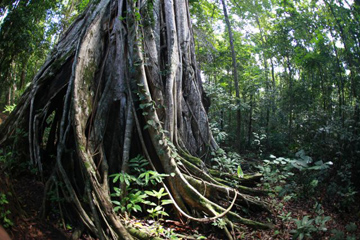 Rainforest in North Sulawesi. Photos by Rhett A. Butler. |
“A two year moratorium is not uncommon in other industries and has a proven track record of allowing those industries to review and re-assess their sustainability issues, while allowing a period for dialogue between governments, NGOs and other third parties,” added Ian Lifshitz, Sustainability & Public Outreach Manager, at APP for the Americas.
The money from Norway has helped advance this thinking. It has shown that the concept of compensated forest protection is indeed real and is now attracting some of Indonesia’s best thinkers to the issue of deforestation, which had been a low priority on the national agenda for too long.
But a billion dollars will only go so far. Norwegian Minister of Environment and International Development Erik Solheim says other rich countries need to support Indonesia’s international commitment to fighting climate change.
“Indonesia has unilaterally committed to achieve great things and the response of the international community to this cannot be business as usual. It must involve support at a scale which matches the changes which Indonesia is willing to implement. The international community must therefore support the new Indonesian approach to REDD+.”
The future of forests in Indonesia depends on it.
Related articles
Corporations, conservation, and the green movement
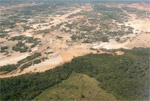
(10/21/2010) The image of rainforests being torn down by giant bulldozers, felled by chainsaw-wielding loggers, and torched by large-scale developers has never been more poignant. Corporations have today replaced small-scale farmers as the prime drivers of deforestation, a shift that has critical implications for conservation. Until recently deforestation has been driven mostly by poverty—poor people in developing countries clearing forests or depleting other natural resources as they struggle to feed their families. Government policies in the ’60s, ’70s, and ’80s had a multiplier effect, subsidizing agricultural expansion through low-interest loans, infrastructure projects, and ambitious colonization schemes, especially in the Amazon and Indonesia. But over the past two decades, this has changed in many countries due to rural depopulation, a decline in state-sponsored development projects, the rise of globalized financial markets, and a worldwide commodity boom. Deforestation, overfishing, and other forms of environmental degradation are now primarily the result of corporations feeding demand from international consumers. While industrial actors exploit resources more efficiently and cause widespread environmental damage, they also are more sensitive to pressure from consumers and environmental groups. Thus in recent years, it has become easier—and more ethical—for green groups to go after corporations than after poor farmers.

(07/29/2010) Many of the environmental issues facing Indonesia are embodied in the plight of the orangutan, the red ape that inhabits the islands of Borneo and Sumatra. Orangutan populations have plummeted over the past century, a result of hunting, habitat loss, the pet trade, and human-ape conflict. Accordingly, governments, charities, and concerned individuals have ploughed tens of millions of dollars into orangutan conservation, but have little to show in terms of slowing or reversing the decline. The same can be said about forest conservation in Indonesia: while massive amounts of money have been put toward protecting and sustainable using forests, the sum is dwarfed by the returns from converting forests into timber, rice, paper, and palm oil. So orangutans—and forests—continue to lose out to economic development, at least as conventionally pursued. Poor governance means that even when well-intentioned measures are in place, they are often undermined by corruption, apathy, or poorly-designed policies. So is there a future for Indonesia’s red apes and their forest home? Erik Meijaard, an ecologist who has worked in Indonesia since 1993 and is considered a world authority on orangutan populations, is cautiously optimistic, although he sees no ‘silver bullet’ solutions.
Indonesia’s plan to save its rainforests

(06/14/2010) Late last year Indonesia made global headlines with a bold pledge to reduce deforestation, which claimed nearly 28 million hectares (108,000 square miles) of forest between 1990 and 2005 and is the source of about 80 percent of the country’s greenhouse gas emissions. President Susilo Bambang Yudhoyono said Indonesia would voluntarily cut emissions 26 percent — and up to 41 percent with sufficient international support — from a projected baseline by 2020. Last month, Indonesia began to finally detail its plan, which includes a two-year moratorium on new forestry concession on rainforest lands and peat swamps and will be supported over the next five years by a one billion dollar contribution by Norway, under the Scandinavian nation’s International Climate and Forests Initiative. In an interview with mongabay.com, Agus Purnomo and Yani Saloh of Indonesia’s National Climate Change Council to the President discussed the new forest program and Norway’s billion dollar commitment.
Are we on the brink of saving rainforests?

(07/22/2009) Until now saving rainforests seemed like an impossible mission. But the world is now warming to the idea that a proposed solution to help address climate change could offer a new way to unlock the value of forest without cutting it down.Deep in the Brazilian Amazon, members of the Surui tribe are developing a scheme that will reward them for protecting their rainforest home from encroachment by ranchers and illegal loggers. The project, initiated by the Surui themselves, will bring jobs as park guards and deliver health clinics, computers, and schools that will help youths retain traditional knowledge and cultural ties to the forest. Surprisingly, the states of California, Wisconsin and Illinois may finance the endeavor as part of their climate change mitigation programs.
Brazil’s plan to save the Amazon rainforest

(06/02/2009) Accounting for roughly half of tropical deforestation between 2000 and 2005, Brazil is the most important supply-side player when it comes to developing a climate framework that includes reducing emissions from deforestation and forest degradation (REDD). But Brazil’s position on REDD contrasts with proposals put forth by other tropical forest countries, including the Coalition for Rainforest Nations, a negotiating block of 15 countries. Instead of advocating a market-based approach to REDD, where credits generated from forest conservation would be traded between countries, Brazil is calling for a giant fund financed with donations from industrialized nations. Contributors would not be eligible for carbon credits that could be used to meet emission reduction obligations under a binding climate treaty.
How to save the Amazon rainforest
(01/04/2009) Environmentalists have long voiced concern over the vanishing Amazon rainforest, but they haven’t been particularly effective at slowing forest loss. In fact, despite the hundreds of millions of dollars in donor funds that have flowed into the region since 2000 and the establishment of more than 100 million hectares of protected areas since 2002, average annual deforestation rates have increased since the 1990s, peaking at 73,785 square kilometers (28,488 square miles) of forest loss between 2002 and 2004. With land prices fast appreciating, cattle ranching and industrial soy farms expanding, and billions of dollars’ worth of new infrastructure projects in the works, development pressure on the Amazon is expected to accelerate. Given these trends, it is apparent that conservation efforts alone will not determine the fate of the Amazon or other rainforests. Some argue that market measures, which value forests for the ecosystem services they provide as well as reward developers for environmental performance, will be the key to saving the Amazon from large-scale destruction. In the end it may be the very markets currently driving deforestation that save forests.


